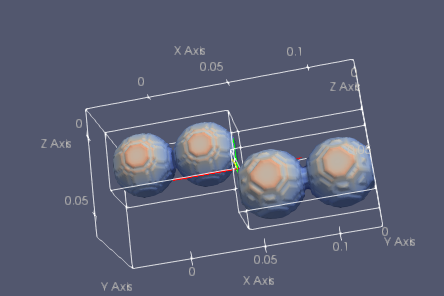Context
The interaction of light (solar, laser) with a particle or a collection of particles generates two phenomena, the “scattering" and the “absorption" of light by the particle. These two phenomena are induced by a local change in the conditions of light propagation, defined by a spatially varying optical index (according to the shape of the irradiated object) and according to its composition. Soot or black carbon are very absorbent materials but they also scatter the light efficiently.
In order to quantify these radiative properties, so-called “cross-sections" are defined. These absorption and scattering cross sections depend on the size, shape, composition of the particle and on the wavelength of the light source.
In the optics and laser department, we are interested in the interaction of light with aggregates of nanoparticles and in particular for specific application of soot particles. The modelling of the radiative properties of these particles has a particularly important impact on the modelling of the radiation in combustion flames or in atmospheric radiation (the presence of soot in the atmosphere is the second anthropological cause of global warming). It also impacts the interpretation of signals collected by developing diagnostics.

Methodology
Still today, many works hypothesize the sphericity of soot particles to predict their capacity to absorb or scatter light. However, this hypothesis soon appeared too strong. Since the early 1990s, simple analytical models such as the RDGFA (Rayleigh Debye Gans Theory for Fractal Aggregates) have been proposed to account for the fractal morphology of nanoparticle aggregates. But since the advent of digital technology and the increase in computing resources, new numerical tools to compute the light-particle interaction have appeared. We are particularly interested here in discrete dipolar approximation (DDA) and generalized Mie theory (T-Matrix/GMM).
Our goal is to improve the RDGFA by testing this theory with exact methods (DDA/T-Matrix/GMM). And to achieve this, we try to understand the role played by each of the parameters (morphological, optical index, wavelength…) on what causes the deviation of the effective cross-sections predicted by the analytical theory (RDG-FA) compared to the real effective cross-sections.
We are particularly interested in the role played by these different parameters on the internal electric field (see illustration) and scattered by these particles (information provided by DDA by solving Maxwell’s equations). This analysis is only possible if the calculations are made on the basis of a realistic and physically consistent generation of the particle aggregates. The impact of these developments is important for the interpretation of the signals resulting from the interaction of laser light with these particles.
On going PhD on this subject : Clément Argentin
Related project : ANR ASTORIA





